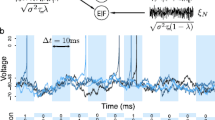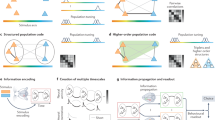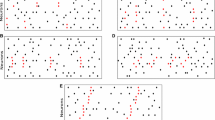Abstract
Multielectrode arrays allow recording of the activity of many single neurons, from which correlations can be calculated. The functional roles of correlations can be revealed by measures of the information conveyed by neuronal activity; a simple formula has been shown to discriminate the information transmitted by individual spikes from the positive or negative contributions due to correlations (Panzeri et al., 1999). Here, this analysis, previously applied to recordings from small ensembles, is developed further by considering a model of a large ensemble, in which correlations among the signal and noise components of neuronal firing are small in absolute value and entirely random in origin. Even such small random correlations are shown to lead to large possible synergy or redundancy, whenever the time window for extracting information from neuronal firing extends to the order of the mean interspike interval. In addition, a sample of recordings from rat barrel cortex illustrates the mean time window at which such “corrections” dominate when correlations are, as often in the real brain, neither random nor small. The presence of this kind of correlations for a large ensemble of cells restricts further the time of validity of the expansion.
Similar content being viewed by others
References
Aertsen AMHJ, Gerstein GL, Habib MK, Palm G (1989) Dynamics of neural firing correlation. J. Neurophysol. 61: 900–917.
Amit DJ (1997) Is synchronization necessary and is it sufficient? Behav. Brain Sci. 20: 683.
Bialek W, Rieke F, de Ruyter van Steveninck RR, Warland D (1991) Reading a neural code. Science 252: 1854–1857.
deCharms RC, Merzenich MM (1996) Primary cortical representation of sounds by the coordination of action potential. Nature 381: 610–613.
Eckhorn R, Pöpel B (1974) Rigorous and extended application of information theory to the afferent visual system of the cat. I. Basic concept. Kybernetik 16: 191–200.
Gawne TJ, Richmond BJ (1993) How independent are the messages carried by adjacent inferior temporal cortical neurons? J. Neurosci. 13: 2758–2771.
Golledge DR, Hildetag CC, Tovee MJ (1996) A solution to the binding problem? Curr. Biol. 6: 1092–1095.
Lebedev MA, Mirabella G, Erchova I, Diamond ME (2000) Experience-dependent plasticity of rat barrel cortex: Redistribution of activity across barrel-columns. Cerebral Cortex 10: 23–31.
Martignon L, Deco G, Laskey K, Diamond M, Freiwald W, Vaadia E (2000) Neural coding: Higher order temporal patterns in the neurostatics of cell assemblies. Neural Comput. 12: 1–33.
Maynard EM, Hatsopoulos NG, Ojakangas CL, Acuna BD, Sanes JN, Normann RA, Donoghue JP (1999) Neuronal interactions improve cortical population coding ofmovement direction. J. Neurosci. 19: 8083–8093.
Optican LM, Richmond BJ (1987) Temporal encoding of twodimensional patterns by single units in primate inferior temporal cortex. III. Information theoretic analysis. J. Neurophysiol. 76: 3986–3982.
Panzeri S, Schultz SR (2001) A unified approach to the study of temporal, correlational and rate coding. Neural Comput. 13: 1311–1349.
Panzeri S, Schultz SR, Treves A, Rolls ET (1999) Correlations and the encoding of information in the nervous system. Proc. Roy. Soc. (London) B 266: 1001–1012.
Panzeri S, Treves A (1996) Analytical estimates of limited sampling biases in different information measures. Network 7: 87–107.
Riehle A, Grun S, Diesmann M, Aertsen AMHJ (1997) Spike synchronization and rate modulation differentially involved in motor cortical function. Science 278: 1950–1953.
Rieke F, Warland D, de Ruyter van Steveninck RR, Bialek W (1996) Spikes: Exploring the Neural Code. MIT Press, Cambridge, MA.
Rolls ET, Treves A (1998) Neural Networks and Brain Function. Oxford University Press, Oxford.
Rolls ET, Treves A, Tovee MJ (1997) The representational capacity of the distributed encoding of information provided by populations of neurons in primate temporal visual cortex. Exper. Brain Res. 114: 149–162.
Shadlen MN, Newsome WT(1998) The variable discharge of cortical neurons: Implications for connectivity, computation and coding. J. Neurosci. 18: 3870–3896.
Shannon CE (1948) A mathematical theory of communication. AT&T Bell Lab. Tech. J. 27: 279–423.
Singer W, Engel AK, Kreiter AK, Munk MHJ, Neuenschwander S, Roelfsema P (1997) Neuronal assemblies: Necessity, signature and detectability. Trends. Cogn. Sci. 1: 252–261.
Skaggs WE, McNaughton BL, Wilson MA, Barnes CA(1992) Quantification of what it is that hippocampal cell fires encodes. Soc.Neurosci. Abstr.: 1216.
Vaadia E, Haalman I, Abeles M, Bergaman H, Prut Y, Slovin H, Aertsen A (1995) Dynamics of neural interactions in monkey cortex in relation to behavioural events. Nature 373: 515–518.
Zohary E, Shadlen MN, Newsome WT (1994) Correlated neuronal discharge rate and its implication for psychophysical performance. Nature 370: 140–143.
Author information
Authors and Affiliations
Rights and permissions
About this article
Cite this article
Bezzi, M., Diamond, M.E. & Treves, A. Redundancy and Synergy Arising from Pairwise Correlations in Neuronal Ensembles. J Comput Neurosci 12, 165–174 (2002). https://doi.org/10.1023/A:1016531312091
Issue Date:
DOI: https://doi.org/10.1023/A:1016531312091




